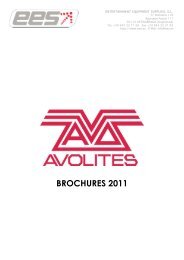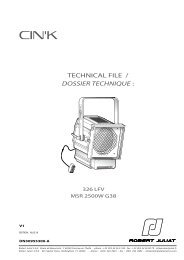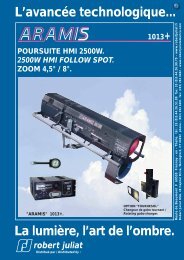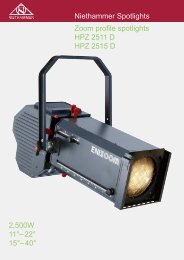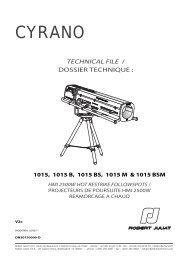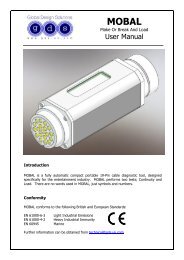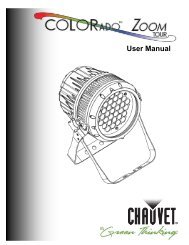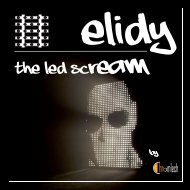You also want an ePaper? Increase the reach of your titles
YUMPU automatically turns print PDFs into web optimized ePapers that Google loves.
User <strong>Manual</strong>
Table of ContentsTable of Contents1. Before You Begin ............................................................................................................1What is Included ............................................................................................................................. 1Unpacking Instructions ................................................................................................................... 1Typographic Conventions ............................................................................................................... 1Icon Meaning .................................................................................................................................. 1Safety Notes ................................................................................................................................... 2Expected LED Lifespan .................................................................................................................. 22. Introduction .....................................................................................................................3Product Description ........................................................................................................................ 3Features ......................................................................................................................................... 3Additional Features .................................................................................................................................... 3Options ...................................................................................................................................................... 3DMX Channel Summary ................................................................................................................. 4Product Overview ........................................................................................................................... 53. Setup ................................................................................................................................6AC Power ....................................................................................................................................... 6AC Plug ..................................................................................................................................................... 6Power Linking ............................................................................................................................................ 6Fuse Replacement ..................................................................................................................................... 6DMX Linking ................................................................................................................................... 7DMX Modes ............................................................................................................................................... 7Master/Slave Connectivity .......................................................................................................................... 7ID Addressing ................................................................................................................................. 7Mounting ........................................................................................................................................ 8Orientation ................................................................................................................................................. 8Rigging ...................................................................................................................................................... 84. Operation .........................................................................................................................9Control Panel Description ............................................................................................................... 9Control Options .............................................................................................................................. 9Programming .................................................................................................................................. 9DMX Personality ........................................................................................................................................ 9DMX Control Without ID Addressing ........................................................................................................... 9DMX Control With ID Addressing .............................................................................................................. 10Static Color .............................................................................................................................................. 10Auto Programs ......................................................................................................................................... 10Edit Customs ........................................................................................................................................... 10Master/Slave............................................................................................................................................ 10Color Adjustment ..................................................................................................................................... 11Dimmer Curves ........................................................................................................................................ 11Control Panel Lock ................................................................................................................................... 11Program Upload ....................................................................................................................................... 11Reset....................................................................................................................................................... 12Whites Setting ......................................................................................................................................... 12White Calibration...................................................................................................................................... 12TOUR Notes ................................................................................................................................. 13Menu Map .................................................................................................................................... 14DMX Values ................................................................................................................................. 15TOUR ...................................................................................................................................................... 15TOUR (Cont.) .......................................................................................................................................... 16ARC1 ...................................................................................................................................................... 16ARC1 + D ................................................................................................................................................ 16AR1 + S ................................................................................................................................................... 16HSV ........................................................................................................................................................ 17COLORado 1-<strong>Tri</strong> <strong>IP</strong> User <strong>Manual</strong> Rev. 01c-a-
Table of Contents5. Technical Information ................................................................................................... 18General Maintenance .................................................................................................................... 18Troubleshooting Guide .................................................................................................................. 19Exploded View .............................................................................................................................. 20Photometrics................................................................................................................................. 21Returns Procedure ........................................................................................................................ 22Claims .......................................................................................................................................... 22Contact Us .................................................................................................................................... 22Technical Specifications................................................................................................................ 23-b-COLORado 1-<strong>Tri</strong> <strong>IP</strong> User <strong>Manual</strong> Rev. 01c
Before You Begin1. Before You BeginWhat isIncludedUnpackingInstructionsTypographicConventions• One COLORado 1-<strong>Tri</strong> <strong>IP</strong>• One proprietary <strong>IP</strong>66 to Edison power input cable (US market)• One proprietary <strong>IP</strong>66 power extension cable• One proprietary <strong>IP</strong>66 signal extension cable• One DMX input cable (proprietary <strong>IP</strong>66 to 3-pin XLR male)• One DMX output cable (proprietary <strong>IP</strong>66 to 3-pin XLR female)• One gel frame holder• One safety cable• Warranty Card• Quick Reference GuideImmediately upon receiving this product, carefully unpack it and check the container inwhich you received it. Make sure that you have received all the parts indicated aboveand that they are all in good condition. If the material inside the container (this productand any other accessory included with it) appears damaged from shipping, or if thecontainer shows signs of mishandling, notify the shipper immediately. In addition, retainthe container and all the packing material for inspection.See the Claims section in the Technical Information chapter.Convention Meaning1~512 A range of values in the text50/60 A set of mutually exclusive values in the text[10] A D<strong>IP</strong> switch to be configuredClaims A new term, or a section or chapter in this document“COLORado UM” The name of another publication or manual A button on the fixture’s control panelSettings A fixture function or a menu optionMENU > Settings A sequence of menu options1~10 A range of menu values from which to choose in a menuYes/No A set of two mutually exclusive menu options in a menuON A unique value to entered or select in a menuIcon MeaningIcon MeaningThis icon indicates critical installation, configuration, or operationinformation. Failure to comply with this information may renderthe fixture partially or completely inoperative, damage third-partyequipment, or cause harm to the user.This icon indicates important installation or configurationinformation. Failure to comply with this information may preventthe fixture from functioning correctly.This icon indicates useful, although non-critical information.The term “DMX” used throughout this document refers to the USITT DMX512-Atransmission protocol.COLORado 1-<strong>Tri</strong> <strong>IP</strong> User <strong>Manual</strong> Rev. 01c -1-
Before You BeginSafety NotesPlease read the following notes carefully because they include important safetyinformation about the installation, usage, and maintenance of this product.It is important to read all these notes before starting to work with this product.There are no user serviceable parts inside this product. Any reference toservicing it you may find from now on in this User <strong>Manual</strong> will only apply toproperly CHAUVET® certified technicians. Do not open the housing or attemptany repairs unless you are one of them.Please refer to all applicable local codes and regulations for the properinstallation of this product.Keep this manual for future consultation. If you sell this product to another user,make sure that they also receive this manual.Personal Safety • Avoid direct eye exposure to the light source while the fixture is on.• Always disconnect this product from its power source before servicing.• Always connect this product to a grounded circuit to avoid the risk of electrocution.• Do not touch this product’s housing when operating because it may be very hot.Mounting and Rigging • This product is for indoor and outdoor use (<strong>IP</strong>66). Do not submerge it.• Make sure there are no flammable materials close to this product while operating.• When hanging this product, always secure it to a fastening device using a safetycable (included).Power and Wiring • Always make sure that you are connecting this product to the proper voltage, asper the specifications in this manual or on the product’s sticker.• Never connect this product to a dimmer pack or rheostat.• Make sure the product’s housing or power cable are not cracked, crimped, ordamaged.• Never disconnect this product by pulling or tugging on the power cable.Operation • Do not operate this fixture if you see damage on the housing, lenses or cables;have the damaged parts replaced by an authorized technician at once.• The maximum ambient temperature (Ta) is 104° F (40° C). Do not operate thisproduct at a higher temperature.• In case of a serious operating problem, stop using this product immediately!In the unlikely event that your CHAUVET® product may require service, pleasecontact CHAUVET® Technical Support.Expected LEDLifespanLEDs gradually decline in brightness over time, mostly because of heat. Packaged inclusters, LEDs exhibit higher operating temperatures than in ideal, single LEDconditions. For this reason, using clustered LEDs at their fullest intensity significantlyreduces the LEDs’ lifespan. Under normal conditions, this lifespan can be of 40,000 to50,000 hours. If extending this lifespan is vital, lower the operational temperature byimproving the fixture’s ventilation and reducing the external temperature. In addition,limiting the overall projection intensity may also help to extend the LEDs’ lifespan.-2- COLORado 1-<strong>Tri</strong> <strong>IP</strong> User <strong>Manual</strong> Rev. 01c
Introduction2. IntroductionProductDescriptionThe COLORado 1-<strong>Tri</strong> <strong>IP</strong> is an RGB wash light based on 14 tri-color LEDs. It consistsof a single pod with a double bracket mounting yoke. The AC power comes directly intothe fixture’s housing through a proprietary <strong>IP</strong>66 rated power input cord. The powerlinking uses a proprietary <strong>IP</strong>66 rated power link cord. The DMX input and output signalsuse proprietary <strong>IP</strong>66 DMX in and DMX out cords. The fixture comes with all thenecessary adapters to connect to the proprietary <strong>IP</strong>66 cords as well a power and signallink cables. The COLORado 1-<strong>Tri</strong> <strong>IP</strong> uses a display-based control panel forprogramming functions.• 3, 4, 5, or 10-channel RGB LED wash light (with ID addressing)Features• Operating modes:3-channel: RGB control3-channel: HSV (hue, saturation, and value) control4-channel: RGB, dimmer5-channel:10-channel:RGB, dimmer, strobeRGB, ID, dimmer, strobe, macro, auto/custom, dimmer speed,auto speed• High power (3W) tri-color (RGB) LEDs• RGB color mixing with or without DMX controller• Automatic programs• User configurable custom programs• Recall auto and custom programs via master/slave or DMX• Color temperature presets (3,200~10,000 K)Additional Features • Five distinct dimming curves• 3-pin DMX input and output connectors• Power linking: max 12 units @ 120 V• LED display with password protection• Gel frame holder (4 mm max thickness)• Double-bracket yoke that doubles as floor stand• Color calibration• Durable and weather resistant <strong>IP</strong>66 rated housing• <strong>IP</strong>66 power and DMX connectorsOptions • 16.4 ft (5 m) power extension cable (<strong>IP</strong>5POWER)• 16.4 ft (5 m) signal extension cable (<strong>IP</strong>5SIG)COLORado 1-<strong>Tri</strong> <strong>IP</strong> User <strong>Manual</strong> Rev. 01c -3-
IntroductionDMX Channel SummaryTOURARC1AR1 + DAR1 + SHSVDMX Channel Function1 Master Dimmer2 Red3 Green4 Blue5 Color Macro6 Strobe7 Auto Programs8 Auto Speed Adjust9 Dimmer Speed10 ID AddressDMX Channel Function1 Red2 Green3 BlueDMX Channel Function1 Master Dimmer2 Red3 Green4 BlueDMX Channel Function1 Master Dimmer2 Red3 Green4 Blue5 StrobeDMX Channel Function1 Hue2 Saturation3 Value-4- COLORado 1-<strong>Tri</strong> <strong>IP</strong> User <strong>Manual</strong> Rev. 01c
IntroductionProduct OverviewSafety cable passagewayPower InPower OutA = 30 mmB = 13 mmDMX InDMX OutControl Panel(Plate removed)COLORado 1-<strong>Tri</strong> <strong>IP</strong> User <strong>Manual</strong> Rev. 01c -5-
SetupDMX LinkingYou may link any COLORado 1-<strong>Tri</strong> <strong>IP</strong> fixture to a DMX controller using a standardDMX serial connection. If using other DMX compatible fixtures with a COLORado 1-<strong>Tri</strong> <strong>IP</strong> fixture, it is possible to control them individually with a single DMX controller.If you are not familiar with the DMX standard, or if you need information about the DMXcables needed to link the COLORado 1-<strong>Tri</strong> <strong>IP</strong> fixture to a DMX controller, you maydownload the “DMX Primer” document from the CHAUVET® Web site.The COLORado 1-<strong>Tri</strong> <strong>IP</strong> comes with two adapter cables, one from proprietary<strong>IP</strong>66 to 3-pin DMX In and the other from proprietary <strong>IP</strong>66 to 3-pin DMX Out. Inaddition, it comes with a signal linking cable with proprietary <strong>IP</strong>66 connectors onboth ends.DMX ModesMaster/SlaveConnectivityThe COLORado 1-<strong>Tri</strong> <strong>IP</strong> uses the standard DMX data connection for its DMX modes,TOUR, ARC1, AR1+D, AR1+S, and HSV.You will find information about these DMX modes in the Introduction chapter (briefdescription), the Operation Instructions chapter (configuration details), and the DMXValues section (individual channel values).The Master/Slave mode allows a COLORado 1-<strong>Tri</strong> <strong>IP</strong> fixture to control one or moreCOLORado 1-<strong>Tri</strong> <strong>IP</strong> fixtures without a DMX controller. The controlling fixture becomesthe “master” when running an auto or custom program as well as when in STATICmode. The controlled fixtures are the “slaves” and you must set them to “SLAVE” modefrom their respective control panels. During the Master/Slave operation, the slavefixtures will operate in unison with the master fixture.The master and slave fixtures link to each other using the standard DMX serialconnection. If you are not familiar with the Master/Slave connectivity, you may downloadthe “DMX Primer” document from the CHAUVET® Web site.DO NOT connect a DMX controller to the fixtures operating in Master/Slave mode.Otherwise, the signals from the DMX controller may interfere with the signals fromthe master unit.The Operation chapter of this manual provides detailed instructions on how toconfigure the Master and Slave units.ID AddressingThe COLORado 1-<strong>Tri</strong> <strong>IP</strong> uses the ID Addressing feature to increase the number ofaddressable fixtures in the same DMX universe when in the TOUR personality. Refer tothe Operation chapter in this manual to learn in detail how to configure theCOLORado 1-<strong>Tri</strong> <strong>IP</strong> fixtures when using ID Addressing. If you are not familiar with thevarious connection methods when using ID Addressing, you may download the “DMXPrimer” document from the CHAUVET® Web site.COLORado 1-<strong>Tri</strong> <strong>IP</strong> User <strong>Manual</strong> Rev. 01c -7-
SetupMountingOrientationRiggingBefore mounting this fixture, read and follow the safety recommendations indicated inthe Safety Notes section (page 2 of this manual).Always mount this fixture in any safe position while making sure that there is adequateroom around it for ventilation, configuration, and maintenance.Make sure to mount this fixture away from any flammable material as indicated in theSafety Notes section.The COLORado 1-<strong>Tri</strong> <strong>IP</strong> consists of a sealed (<strong>IP</strong>66) housing with a double bracketmounting yoke. It has two DMX signal cables (DMX In/DMX Out), and two power cables(Power In/Power Out), all of them fitted with proprietary <strong>IP</strong>66 connectors.CHAUVET® recommends following the general guidelines below when mounting theCOLORado 1-<strong>Tri</strong> <strong>IP</strong>.• When selecting an installation location, consider ease of access to the fixture foroperation, programming adjustments, and routine maintenance.• If hanging this fixture, make sure that the location where you are mounting thefixture can support its weight. Please see the Technical Specifications section of thismanual for the weight requirement of this fixture.ProcedureThe COLORado 1-<strong>Tri</strong> <strong>IP</strong> includes a safety cable and a mounting yoke to which youcan attach one or two rigging clamps. You must supply your own “C” or “O” clamps andmake sure that they are capable of supporting the weight of this fixture. Although it ispossible to use a single clamp per fixture, CHAUVET® recommends using two clampsper fixture. Secure the fixture with the safety cable after mounting it to the truss.C clamp(not included).Product MountingDiagramFloor MountingSecure the safety cable usingthe passageway on the backof the fixture.Overhead Mounting-8- COLORado 1-<strong>Tri</strong> <strong>IP</strong> User <strong>Manual</strong> Rev. 01c
Operation4. OperationControl PanelDescriptionButtonFunctionExits from the current menu orfunctionEnables the currently displayedmenu or sets the currentlyselected value in to the currentfunctionNavigates upwards through themenu list and increases thenumeric value when in a functionNavigates downwards throughthe menu list and decreases thenumeric value when in a functionControl OptionsYou can set the COLORado 1-<strong>Tri</strong> <strong>IP</strong> start address in the 001~512 DMX range. Thisallows for the control of up to 51 fixtures in the 10-channel TOUR personality. Inaddition, the ID address system allows you to assign up to 66 fixtures within the sameDMX address, thus multiplying the number of fixtures you can control within a singleuniverse. You can access the fixture’s ID address system from channel 10 when in theTOUR personality.When programming live performances as well as cues that need to trigger ondemand or on a time line, program no more than 10 fixtures on ID addressing perDMX channel. This is to remain within a one-second execution time.ProgrammingDMX PersonalityDMX ControlWithout IDAddressingCarry out all the programming procedures indicated below from the control panel. Referto the Menu Map on page 14 to learn how the menu options relate to each other.To go to an option, press repeatedly until the option shows on the display.To select an option value, press or until you see the desired value andpress to accept it.To exit to the previous menu level, press .This setting allows the user to choose a particular DMX personality.1) Go to PERS.2) Select the desired personality (TOUR, ARC1, AR1 + D, AR1 + S, or HSV).3) Make sure that the starting addresses on the various fixtures do not overlap due tothe new personality setting. See the DMX Values section.In this mode, each unit will respond to a unique starting address from the DMXcontroller. All units with the same starting address will respond in unison.1) Select the TOUR personality as shown in DMX Personality.2) Set the running mode:a) Go to RUN.b) Select DMX.3) Set the starting address:a) Go to DMX.b) Select the starting address (001~512).4) Deactivate ID Addressing on each fixture:a) Go to SET > ID.b) Select OFF.Make sure to deactivate ID Addressing in each fixture when using the TOURpersonality. Otherwise, unintended results may occur if channel 10 is not set to“0”.Continues on the next pageCOLORado 1-<strong>Tri</strong> <strong>IP</strong> User <strong>Manual</strong> Rev. 01c -9-
OperationContinued from previous pageDMX Control With IDAddressingStatic ColorAuto ProgramsIn this mode, the fixtures with the same DMX starting address will respond to the DMXcontroller based on the fixture’s individual ID address setting. If the user selects IDaddress “0”, all the fixtures with the same DMX address will respond in unison.Otherwise, each fixture will follow the control for its particular ID address.1) Repeat steps 1, 2, and 3 from DMX Control Without ID Addressing.2) Activate ID Addressing in each fixture:a) Go to SET > ID.b) Select ON.3) Select an ID address for each fixture:a) Go to ID.b) Select an ID (01~66)The Static Color mode allows for permanent RGB color mixing without a DMX controller.1) Go to STAT.2) Select the desired color (Red, Green, or Blue).3) Select the desired color value (0~255).4) Repeat for the other colors.5) Select Strob.6) Select the desired frequency (0~20).Auto programs allow for dynamic RGB color mixing without a DMX controller.1) Go to AUTO.2) Select the desired auto program (AT. 01~10 or PR. 01~10).You cannot edit auto programs AT. 01~10. However you can edit PR. 01~10 (seeEdit Customs).Edit Customs This setting allows for the programming of up to 30 scenes for each of the 10customizable programs, including colors and effects.1) Go to EDIT.2) Select the desired auto program (PR. 01~10).3) Select the desired scene (SC. 01~30).4) Select the desired color or effect (Red, Green, Blue, Strobe, Time, or Fade).5) Select the desired value for the color or effect (000~255 for colors and timers, or00~20 for Strobe).6) Repeat for the other colors or effects.7) Repeat for the other scenes.Master/SlaveThe Master/Slave mode allows a group of COLORado 1-<strong>Tri</strong> <strong>IP</strong> fixtures (the slaves) toexecute simultaneously the same program, whether auto or custom, that anotherCOLORado 1-<strong>Tri</strong> <strong>IP</strong> fixture (the master) is executing, without a DMX controller.1) Set the Master Unit:a) Set the running mode to DMX as explained in “DMX Control Without IDAddressing”.b) Select an auto program as explained in “Auto Programs”.2) Set the slave units:a) Go to RUN.b) Select SLAV.• The fixture that runs an auto program automatically becomes the Master.• Do not connect a DMX controller to the master or slave fixtures.Continues on the next page-10- COLORado 1-<strong>Tri</strong> <strong>IP</strong> User <strong>Manual</strong> Rev. 01c
OperationContinued from previous pageColor AdjustmentThe COLOR setting determines how the COLORado 1-<strong>Tri</strong> <strong>IP</strong> displays the white colorwhen the Red, Green, and Blue faders are all at the “255” value.1) Go to SET > Color.2) Select OFF, RGBW, or UC.SettingOFFRGBWUCDescriptionWhen R, G, and B are “255,” the output will be at its maximum.When R, G, and B are “255,” CAL2 will determine the output.When R, G, and B are “255,” the output will match that of fixtures fromprevious generations.Dimmer CurvesThis setting determines how the output of the COLORado 1-<strong>Tri</strong> <strong>IP</strong> follows the positionof the Dimmer fader, as well as the Red, Green, and Blue faders.1) Go to SET > Dim.2) Select a dimmer curve (Off, Dim1, Dim2, Dim3, or Dim4).SettingOFFDim1Dim2Dim3Dim4DescriptionThe output is proportional to the faders’ position (linear)The output is not proportional (fastest)The output is not proportional (fast)The output is not proportional (slow)The output is not proportional (slowest)Control Panel LockThis setting allows the user to activate or disable the control panel lock, which keepsnon-authorized personnel from changing the fixture’s settings.1) Go to KEY.2) Select On/ Off.When the control panel lock is active, the fixture will prompt the user to enter thepassword after 30 seconds of control panel inactivity or after turning on thefixture.After being prompted to enter the password:1) Press , , , , and .Program UploadThis option allows the user to copy the custom programs of one COLORado 1-<strong>Tri</strong> <strong>IP</strong>fixture onto other COLORado 1-<strong>Tri</strong> <strong>IP</strong> fixtures by using the Master/Slave method.1) Configure and connect the fixtures in a Master/Slave arrangement, where themaster unit has the custom programs you want to transfer onto the slave units.2) At the master unit, go to SET > UPLD.3) When prompted, enter the master access password as shown in Control PanelLock.4) Wait for the upload process to finish before disconnecting the fixtures.During and after the upload, the master and slave units will visually indicate the status ofthe process, as follows:ColorYellowRedGreenMeaningThe upload process is runningThe upload failed due to an errorThe upload finished successfullyContinues on the next pageCOLORado 1-<strong>Tri</strong> <strong>IP</strong> User <strong>Manual</strong> Rev. 01c -11-
OperationContinued from previous pageResetWhites SettingWhite CalibrationThis setting allows the user to reset the COLORado 1-<strong>Tri</strong> <strong>IP</strong> fixture to its defaultvalues, including the custom programs.1) Go to SET> REST.2) When prompted, enter the master access password as shown in Control PanelLock.3) Wait for the reset process to finish.This setting allows the user to edit the temperature of the 11 white colors used in theMacros channel. The 11 pre-set whites are configurable.1) Go to CAL1.2) Select a white color (WT. 1~11).3) Select a color (Red, Green, or Blue).4) Select a color value (0~255).5) Repeat for the other colors (Red, Green, or Blue).6) Repeat for the other white colors (WT. 1~11).This setting allows the user to select the white color shown by the COLORado 1-<strong>Tri</strong> <strong>IP</strong>when the color setting is RGBW and the DMX controller’s Red, Green, and Blue fadersare set to “255”.1) Go to CAL2 > RGBW.2) Select a color (Red, Green, or Blue).3) Select a color value (0~255).4) Repeat for the other colors (Red, Green, or Blue).-12- COLORado 1-<strong>Tri</strong> <strong>IP</strong> User <strong>Manual</strong> Rev. 01c
OperationTOUR NotesMaster DimmerRed, Green, & BlueColor SelectionColor MacrosThese notes intent to clarify the way the TOUR DMX personality works.• Channel 1 controls the intensity of the currently projected color.• When the slider is at the highest position (255) the intensity of the output is at itsmaximum.• Channels 2, 3, and 4 control the intensity ratio of each of the Red, Green, and BlueLEDs.• When the slider is at the highest position (255), the intensity of each color is at itsmaximum.• You can combine channels 2, 3, and 4 to create over 16 million colors.• Channel 5 selects the required Color Macro.• Channel 5 has priority over channels 2, 3, and 4.• Channel 1 controls the intensity of the Color Macro.Strobe • Channel 6 controls the strobe frequency (not the intensity) of channels 2~5.• Channel 6 strobes channels 2, 3, and 4 when not running macros, allowing theindividual faders (R, G, and B) as well as channel 1 (D) to control the outputintensity.• Channel strobes channel 6 when running macros, allowing channel 6 to select themacro and channel 1 to control the output intensity.AutoDimmer SpeedID AddressSelection• Channel 7 selects the preset auto programs AT. 01~10 or the custom programsCUS. 01~10.• When activating the custom programs CUS. 01~10, it is possible to control the StepTime and Fade Time using channels 2 and 3 respectively.• Channel 7 has priority over channels 2, 3, 4, 5, and 6.• Channel 9 is for selecting the dimmer mode and speed. When Dimmer is set to Off,the Red, Green, Blue, and Dimmer outputs are linear with the faders. Otherwise,Dim1 is the fastest dimmer curve, while Dim4 is the slowest.• Channel 10 selects the target ID address.• Each independent DMX address may have up to 66 independent ID addresses.• An ID address of 0 will activate all ID address locations.COLORado 1-<strong>Tri</strong> <strong>IP</strong> User <strong>Manual</strong> Rev. 01c -13-
OperationMenu Map-14- COLORado 1-<strong>Tri</strong> <strong>IP</strong> User <strong>Manual</strong> Rev. 01c
OperationDMX ValuesTOUR Channel Function Value Percent/Setting1 Master Dimmer 000 255 0~100%2Red0~100% (or)000 255Step TimeWhen playing a custom program3Green0~100% (or)000 255Fade TimeWhen playing a custom program4 Blue 000 255 0~100%5 Color Macro6 Strobe7 Auto000 010011 030031 050051 070071 090091 110111 130131 150151 170171 200201 205206 210211 215216 220221 225226 230231 235236 240241 245246 250251 255000 010011 255000 020021 030031 040041 050051 060061 070071 080081 090091 100101 110111 120121 130131 140141 150151 160161 170171 180181 190191 200201 210211 220221 255No functionR: 100% G: Up B: 0%R: Down G: 100% B: 0%R: 0% G: 100% B: UpR: 0% G: Down B: 100%R: Up G: 0% B: 100%R: 100% G: 0% B: DownR: 100% G: Up B: UpR: Down G: Down B: 100%R: 100% G: 100% B: 100% W: 100%White 1: 3,200 KWhite 2: 3,400 KWhite 3: 4,200 KWhite 4: 4,900 KWhite 5: 5,600 KWhite 6: 5,900 KWhite 7: 6,500 KWhite 8: 7,200 KWhite 9: 8,000 KWhite 10: 8,500 KWhite 11: 10,000 KNo function0~20 HzNo functionAuto 1Auto 2Auto 3Auto 4Auto 5Auto 6Auto 7Auto 8Auto 9Auto 10Custom 1Custom 2Custom 3Custom 4Custom 5Custom 6Custom 7Custom 8Custom 9Custom 10No function8 Auto Speed 000 255 0~100% (Only when playing an automatic program)000 009 Use dimmer speed from control panel010 029 Linear dimmer9 Dimmer Speed030 069 Non-linear dimmer 1 (fastest)070 129 Non-linear dimmer 2130 189 Non-linear dimmer 3190 255 Non-linear dimmer 4 (slowest)Continues on the next pageCOLORado 1-<strong>Tri</strong> <strong>IP</strong> User <strong>Manual</strong> Rev. 01c -15-
OperationContinued from previous pageTOUR (Cont.)Channel Function Value Setting Value Setting Value Setting10 ID Address000 009010 019020 029030 039040 049050 059060 069070 079080 089090 099100 109110 119120 129130 139140 149150 159160 169170 179180 189190 199200 209210211All IDsID 1ID 2ID 3ID 4ID 5ID 6ID 7ID 8ID 9ID 10ID 11ID 12ID 13ID 14ID 15ID 16ID 17ID 18ID 19ID 20ID 21ID 22212213214215216217218219220221222223224225226227228229230231232233234ID 23ID 24ID 25ID 26ID 27ID 28ID 29ID 30ID 31ID 32ID 33ID 34ID 35ID 36ID 37ID 38ID 39ID 40ID 41ID 42ID 43ID 44ID 45235236237238239240241242243244245246247248249250251252253254255ID 46ID 47ID 48ID 49ID 50ID 51ID 52ID 53ID 54ID 55ID 56ID 57ID 58ID 59ID 60ID 61ID 62ID 63ID 64ID 65ID 66ARC1 Channel Function Value Percent/Setting1 Red 000 255 0~100%2 Green 000 255 0~100%3 Blue 000 255 0~100%ARC1 + D Channel Function Value Percent/Setting1 Master Dimmer 000 255 0~100%2 Red 000 255 0~100%3 Green 000 255 0~100%4 Blue 000 255 0~100%AR1 + S Channel Function Value Percent/Setting1 Master Dimmer 000 255 0~100%2 Red 000 255 0~100%3 Green 000 255 0~100%4 Blue 000 255 0~100%000 010 No function5 Strobe011 255 0~20 HzContinues on the next page-16- COLORado 1-<strong>Tri</strong> <strong>IP</strong> User <strong>Manual</strong> Rev. 01c
OperationContinued from previous pageHSV Channel Function Value Percent/Setting1 Hue 000 255 0~100%2 Saturation 000 255 0~100%3 Value 000 255 0~100%• “Hue” refers to the visible light, such as red, yellow, and cyan, etc.• “Saturation” indicates the dominance of hue in the color; when saturation is at 100%,the color is at its purest.• “Value” is the color’s brightness; when value is at 100%, the color is at its brightest.COLORado 1-<strong>Tri</strong> <strong>IP</strong> User <strong>Manual</strong> Rev. 01c -17-
Technical Information5. Technical InformationGeneralMaintenanceTo maintain optimum performance and minimize wear, the user should clean the lightfixtures frequently. Usage and environment are contributing factors in determining thecleaning frequency. As a rule, the user should clean the fixtures at least twice a month.Dust build up reduces light output performance and can cause overheating. This canlead to reduced light source life and increased mechanical wear.CHAUVET® recommends cleaning the fixture’s external optics with a soft cloth usingnormal glass cleaning fluid.To clean a fixture, follow the recommendations below:• Unplug the fixture from power.• Wait until the fixture is cold.• Use a vacuum (or dry compressed air) and a soft brush to remove dust collectedon the external vents and reachable internal components.• Clean all external optics and glass surfaces with a mild solution of glass cleaner orisopropyl alcohol, and a soft, lint free cotton cloth or a lens cleaning tissue.• Apply the solution directly to the cloth or tissue and drag any dirt and grime to theoutside of the lens.• Gently polish the external glass surfaces until they are free of haze and lint.• When cleaning units with a movable mirror, you should keep the contact with themirror surface to a minimum to avoid scratching or damaging it.Always dry the external optics and glass surfaces carefully after cleaning them.If the fixture has one or more cooling fans, refrain from spinning them usingcompressed air.-18- COLORado 1-<strong>Tri</strong> <strong>IP</strong> User <strong>Manual</strong> Rev. 01c
Technical InformationTroubleshooting GuideSymptom Cause(s) Action(s)General low light intensityA single tri color LEDdoes not illuminateA group of tri-color LEDsdoes not illuminateNone of the LEDs areilluminatingBreaker/Fuse keepsblowingFixture does not power upFixture does not respondto DMXDMX signal problems• Dirty lens assembly• Misaligned lens assembly• Faulty LED• Faulty LED board• Faulty LED• Faulty LED board• Faulty LED driver• Faulty LED PCB• Faulty LED Driver PCB• Faulty main PCB• Excessive circuit load• Short circuit along the power wires• No power• Loose or damaged power cord• Blown internal fuse• Faulty internal power supply• Wrong DMX addressing• Damaged DMX cables• Wrong polarity on the controller• Loose DMX cables• Faulty DMX interface• Faulty Main PCB• Non DMX cables• Bouncing signals• Long cable / low level signal• Too many fixtures• Interference from AC wires• Clean the fixture regularly• Install lens assembly properly• Replace the LED board• Replace the LED board• Replace the LED board• Replace the LED board• Replace the LED driver board• Replace the LED board• Replace the LED driver board• Replace the Display / Main board• Check total load placed on the electrical circuit• Check for a short in the electrical wiring• Check for power on power outlet• Check power cord• Replace internal fuse• Replace internal power supply• Check Control Panel and unit addressing• Check DMX cables• Check polarity switch settings on the controller• Check cable connections• Replace Main PCB• Replace Main PCB• Use only DMX compatible cables• Install terminator as suggested• Install an optically coupled DMX splitter rightafter fixture with strong signal• Install an optically coupled DMX splitter afterunit #32• Keep DMX cables separated from power cablesor black lightsIf you still experience technical problems after trying the above solutions, contactCHAUVET® Technical Support.COLORado 1-<strong>Tri</strong> <strong>IP</strong> User <strong>Manual</strong> Rev. 01c -19-
Technical InformationExploded ViewItem Description Item Description1 Front cover 11 Display clear plate2 Rubber seal (*) 12 Button seal3 Clear glass 13 Casing4 Lens complete set 14 Stainless steel knob5 LED board 15 Power cord gland6 Heat sink 16 Display protection plate7 Power supply 17 Display plate seal8 Driver board 18 DMX cable gland9 Power connection board 19 Main bracket10 Display board 20 Secondary bracket(*):The rubber seal can be a separate ring or it may come mounted around theglass cover-20- COLORado 1-<strong>Tri</strong> <strong>IP</strong> User <strong>Manual</strong> Rev. 01c
Technical InformationPhotometricsCOLORado 1-<strong>Tri</strong> <strong>IP</strong> User <strong>Manual</strong> Rev. 01c -21-
Technical InformationReturnsProcedureThe user must send the merchandise prepaid, in the original box, and with its originalpacking and accessories. CHAUVET® will not issue call tags.Call CHAUVET® and request a Return Merchandise Authorization Number (RMA #)before shipping the fixture. Be prepared to provide the model number, serial number,and a brief description of the cause for the return.The user must clearly label the package with a Return Merchandise AuthorizationNumber (RMA #). CHAUVET® will refuse any product returned without an RMA #.DO NOT write the RMA # directly on the box. Instead, write it on a properly affixedlabel.Once you receive the RMA #, please include the following information on a piece ofpaper inside the box:• Your name• Your address• Your phone number• The RMA #• A brief description of the problemBe sure to pack the fixture properly. Any shipping damage resulting from inadequatepackaging will be the customer’s responsibility. As a suggestion, proper UPS packing ordouble-boxing is always a safe method to use.CHAUVET® reserves the right to use its own discretion to repair or replacereturned product(s).ClaimsThe carrier is responsible for any damage incurred during shipping to this product or anypart that shipped with it. Therefore, if the received merchandise appears to havedamages caused during shipping, the customer must submit the damage report and anyrelated claims with the carrier, not CHAUVET®. The customer must submit the reportupon reception of the damaged merchandise. Failure to do so in a timely manner mayinvalidate the customer’s claim with the carrier.For other issues such as missing components or parts, damage not related to shipping,or concealed damage, the customer must make claims to CHAUVET® within seven (7)days of receiving the merchandise.Contact UsWorld HeadquartersGeneral InformationTechnical SupportWorld Wide WebCHAUVET®5200 NW 108th AvenueSunrise, FL 33351Voice: (954) 929-1115Fax: (954) 929-5560Toll free: (800) 762-1084Voice: (954) 929-1115 (Press 4)Fax: (954) 756-8015www.chauvetlighting.com-22- COLORado 1-<strong>Tri</strong> <strong>IP</strong> User <strong>Manual</strong> Rev. 01c
Technical InformationTechnical SpecificationsDimensions and Weight Length Width Height Weight9.6 in (245 mm) 8.0 in (205 mm) 9.6 in (245 mm) 10.6 lbs (4.8 kg)Note: Dimensions in inches rounded to the nearest decimal digit.Power Power Supply Type Range Voltage SelectionSwitching (internal) 100~240 V, 50/60 Hz Auto-rangingParameter 120 V, 60 Hz 230 V, 50 HzConsumption 88 W (0.7 A) 88 W (0.4 A)Inrush current 0.4 A 0.4 APower Linking 12 units 24 unitsPower I/O Input OutputConnectors In-line proprietary <strong>IP</strong>66 In-line proprietary <strong>IP</strong>66Cord plug (US) Proprietary <strong>IP</strong>66 to Edison Proprietary <strong>IP</strong>66Light Source Type Power LifespanLED 3 W 50,000 hoursColor Quantity Current<strong>Tri</strong>-color (RGB) 14 1,050 mA per diePhoto Optic Parameter Standard 16º OpticsIlluminance @ 5 m306 lxBeam angle 17ºField angle 32ºThermal Maximum External Temp. Cooling System104° F (40° C) ConvectionDMX I/O Connectors Connector Type Channel Range3-pin XLR (<strong>IP</strong>66 adapter) In-line 3, 4, 5, and 10Ordering COLORado 1-<strong>Tri</strong> <strong>IP</strong> Power extension cable Signal extension cableCOLORADO1TRI<strong>IP</strong> <strong>IP</strong>5POWER <strong>IP</strong>5SIGCOLORado 1-<strong>Tri</strong> <strong>IP</strong> User <strong>Manual</strong> Rev. 01c -23-
CHAUVET®5200 NW 108th AvenueSunrise, FL 33351 (USA)(800) 762-1084 – (954) 929-1115FAX (954) 929-5560www.chauvetlighting.comCOLORado 1-<strong>Tri</strong> <strong>IP</strong> User <strong>Manual</strong> Rev. 01cDecember 2010



